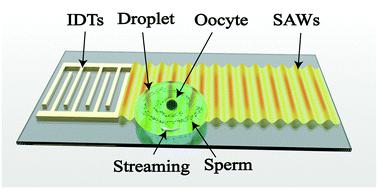Our official English website, www.x-mol.net, welcomes your
feedback! (Note: you will need to create a separate account there.)
Acoustic enrichment of sperm for in vitro fertilization
Lab on a Chip ( IF 6.1 ) Pub Date : 2024-10-11 , DOI: 10.1039/d4lc00604f Chunqiu Zhang, Ning Rong, Ziyi Lin, Peng-Qi Li, Jingyao Shi, Wei Zhou, Lili Niu, Fei Li, Rongxin Tang, Lei Li, Long Meng
Lab on a Chip ( IF 6.1 ) Pub Date : 2024-10-11 , DOI: 10.1039/d4lc00604f Chunqiu Zhang, Ning Rong, Ziyi Lin, Peng-Qi Li, Jingyao Shi, Wei Zhou, Lili Niu, Fei Li, Rongxin Tang, Lei Li, Long Meng

|
Assisted reproductive technology (ART) has emerged as a crucial method in modern medicine for tackling infertility. However, the success of fertilization depends on the quality and quantity of sperm, often necessitating invasive surgical intervention, which presents challenges for non-invasive in vitro fertilization. Acoustic microfluidics technology has found widespread application across various biological contexts. In this paper, we propose to introduce a novel approach using asymmetric acoustic streaming generated by a single interdigital transducer (IDT) to enhance sperm concentration and improve fertilization in vitro, particularly in cases of moderate oligozoospermia. The concentration of particles increased approximately 6-fold in the central region after acoustic enrichment. Moreover, sperm motility was significantly improved without additional DNA fragmentation, and all the oocytes remained viable after 5 min of acoustic enrichment. Notably, acoustic enrichment accelerated fertilization and embryo development, leading to a higher fertilization rate and faster cleavage speed. Specifically, within 36 hours, the multiple-cell embryo ratio was significantly increased compared to the control group. This finding further validates the feasibility and non-invasiveness of acoustic enrichment for sperm fertilization in vitro. This work provides a promising tool for in vitro fertilization, holding significant implications for assisted reproduction.
中文翻译:

用于体外受精的精子的声学富集
辅助生殖技术 (ART) 已成为现代医学中解决不孕症的重要方法。然而,受精的成功取决于精子的质量和数量,通常需要侵入性手术干预,这给无创体外受精带来了挑战。声学微流体技术已在各种生物环境中得到广泛应用。在本文中,我们建议引入一种新方法,使用由单个指间换能器 (IDT) 产生的不对称声流来提高精子浓度并改善体外受精,特别是在中度少精症的情况下。声富集后,中心区域的颗粒浓度增加了约 6 倍。此外,精子活力在没有额外 DNA 片段化的情况下得到显着改善,并且在声学富集 5 分钟后所有卵母细胞仍然存活。值得注意的是,声学富集加速了受精和胚胎发育,导致更高的受精率和更快的卵裂速度。具体而言,在 36 小时内,与对照组相比,多细胞胚胎比率显著增加。这一发现进一步验证了声学富集在体外精子受精的可行性和非侵入性。这项工作为体外受精提供了一种有前途的工具,对辅助生殖具有重要意义。
更新日期:2024-10-11
中文翻译:

用于体外受精的精子的声学富集
辅助生殖技术 (ART) 已成为现代医学中解决不孕症的重要方法。然而,受精的成功取决于精子的质量和数量,通常需要侵入性手术干预,这给无创体外受精带来了挑战。声学微流体技术已在各种生物环境中得到广泛应用。在本文中,我们建议引入一种新方法,使用由单个指间换能器 (IDT) 产生的不对称声流来提高精子浓度并改善体外受精,特别是在中度少精症的情况下。声富集后,中心区域的颗粒浓度增加了约 6 倍。此外,精子活力在没有额外 DNA 片段化的情况下得到显着改善,并且在声学富集 5 分钟后所有卵母细胞仍然存活。值得注意的是,声学富集加速了受精和胚胎发育,导致更高的受精率和更快的卵裂速度。具体而言,在 36 小时内,与对照组相比,多细胞胚胎比率显著增加。这一发现进一步验证了声学富集在体外精子受精的可行性和非侵入性。这项工作为体外受精提供了一种有前途的工具,对辅助生殖具有重要意义。































 京公网安备 11010802027423号
京公网安备 11010802027423号